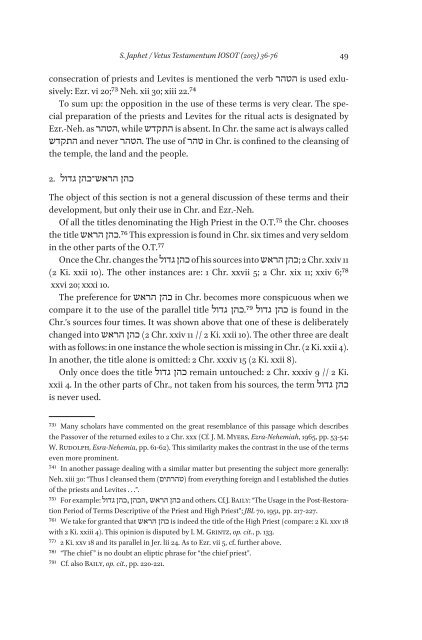Special Issue IOSOT 2013 - Books and Journals
Special Issue IOSOT 2013 - Books and Journals
Special Issue IOSOT 2013 - Books and Journals
Create successful ePaper yourself
Turn your PDF publications into a flip-book with our unique Google optimized e-Paper software.
S. Japhet / Vetus Testamentum <strong>IOSOT</strong> (<strong>2013</strong>) 36-76 49<br />
consecration of priests <strong>and</strong> Levites is mentioned the verb הטהר is used exlusively:<br />
Ezr. vi 20;73 Neh. xii 30; xiii 22.74<br />
To sum up: the opposition in the use of these terms is very clear. The special<br />
preparation of the priests <strong>and</strong> Levites for the ritual acts is designated by<br />
Ezr.-Neh. as ,הטהר while התקדש is absent. In Chr. the same act is always called<br />
in Chr. is confined to the cleansing of טהר The use of .הטהר <strong>and</strong> never התקדש<br />
the temple, the l<strong>and</strong> <strong>and</strong> the people.<br />
כהן הראש־כהן גדול .2<br />
The object of this section is not a general discussion of these terms <strong>and</strong> their<br />
development, but only their use in Chr. <strong>and</strong> Ezr.-Neh.<br />
Of all the titles denominating the High Priest in the O.T.75 the Chr. chooses<br />
the title 76.כהן הראש This expression is found in Chr. six times <strong>and</strong> very seldom<br />
in the other parts of the O.T.77<br />
Once the Chr. changes the כהן גדול of his sources into ;כהן הראש 2 Chr. xxiv 11<br />
(2 Ki. xxii 10). The other instances are: 1 Chr. xxvii 5; 2 Chr. xix 11; xxiv 6;78<br />
xxvi 20; xxxi 10.<br />
The preference for כהן הראש in Chr. becomes more conspicuous when we<br />
compare it to the use of the parallel title כהן גדול 79.כהן גדול is found in the<br />
Chr.’s sources four times. It was shown above that one of these is deliberately<br />
changed into כהן הראש (2 Chr. xxiv 11 // 2 Ki. xxii 10). The other three are dealt<br />
with as follows: in one instance the whole section is missing in Chr. (2 Ki. xxii 4).<br />
In another, the title alone is omitted: 2 Chr. xxxiv 15 (2 Ki. xxii 8).<br />
Only once does the title כהן גדול remain untouched: 2 Chr. xxxiv 9 // 2 Ki.<br />
כהן גדול xxii 4. In the other parts of Chr., not taken from his sources, the term<br />
is never used.<br />
73) Many scholars have commented on the great resemblance of this passage which describes<br />
the Passover of the returned exiles to 2 Chr. xxx (Cf. J. M. Myers, Ezra-Nehemiah, 1965, pp. 53-54;<br />
W. Rudolph, Esra-Nehemia, pp. 61-62). This similarity makes the contrast in the use of the terms<br />
even more prominent.<br />
74) In another passage dealing with a similar matter but presenting the subject more generally:<br />
Neh. xiii 30: “Thus I cleansed them (טהרתים) from everything foreign <strong>and</strong> I established the duties<br />
of the priests <strong>and</strong> Levites . . .”.<br />
75) For example: כהן הראש ,הכהן ,כהן גדול <strong>and</strong> others. Cf. J. Baily: “The Usage in the Post-Restoration<br />
Period of Terms Descriptive of the Priest <strong>and</strong> High Priest”; JBL 70, 1951, pp. 217-227.<br />
76) We take for granted that כהן הראש is indeed the title of the High Priest (compare: 2 Ki. xxv 18<br />
with 2 Ki. xxiii 4). This opinion is disputed by I. M. Grintz, op. cit., p. 133.<br />
77) 2 Ki. xxv 18 <strong>and</strong> its parallel in Jer. lii 24. As to Ezr. vii 5, cf. further above.<br />
78) “The chief ” is no doubt an eliptic phrase for “the chief priest”.<br />
79) Cf. also Baily, op. cit., pp. 220-221.








![Am HaSefer [Volk des Buches] - Books and Journals](https://img.yumpu.com/20648352/1/174x260/am-hasefer-volk-des-buches-books-and-journals.jpg?quality=85)







